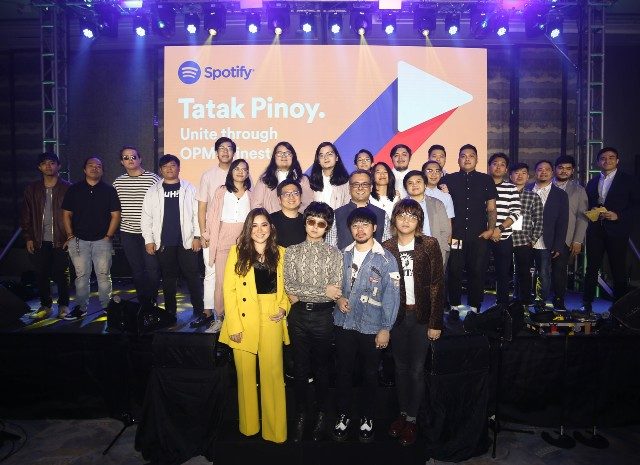SUMMARY
This is AI generated summarization, which may have errors. For context, always refer to the full article.

MANILA, Philippines – That Spotify has managed to become a force in the local music industry is no surprise.
In the Philippines, especially, its reach is phenomenal – the company itself estimates that 73% of music revenue now comes from streaming. In a country where piracy is particularly prevalent and laughably, easy, that’s something of an achievement.
Spotify, which first entered the country in 2014, said its Filipino users spend at least two hours a day on the streaming app – with most streams happening from 10 pm to midnight (before sleeping, we suppose?) and between 3 pm and 6 pm daily.
Musicians and their labels have also taken notice – artists frequently count YouTube and Spotify as game changers in how music has been consumed, marketed, and released in the Philippines.
On the sidelines of an event to launch Spotify’s latest project – where top local artists cover classic Filipino love songs (fun fact: the most searched terms in the Philippines are: love, OPM, and Pinoy) – Rappler spoke to the company’s top regional executives about Filipino music, the formula for success, and where Spotify wants to be in the Filipino music industry.
RAPPLER: What’s changed since Spotify launched in the Philippines?
Chee Meng, head of artist and label marketing, Southeast Asia: 2014, we were there. We started off with the global service but then we took the next step, the natural evolution which was to actually localize for the Philippine market. So we did that and this is when we got a Philippines editor and we had a full team dedicated to the Philippines. So what you see today really is a reflection of all the work that the team has put together.
Ben Chelliah, Spotify Asia head of communications: During that period of time – from the time we launched to 2015 when we kind of reintroduced the whole localized hub for OPM, I think something we noticed from the data is that the number of people that was streaming local content and we kind of saw a spike in terms of the search terms and the necessity of having it localized because at the end of the day, every country, every region is very different and the listening habits are very different. So we wanted to make sure that what we provide to our users is very much what they’re looking for as well so there was a need for us to kind of introduce that as well.
It’s been 5 years since Spotify launched in the Philippines. It’s become an integral part of many young millennials’ lives. Did you expect it to be this big this fast in the Philippines, considering the Philippines does have piracy problems?
Gautam Talwar, managing director, Southeast Asia: It’s interesting you say that because if someone would have had a tunnel vision of where we would be 5 years from now, you know, it would have been hard to digest. Looking back, this should not be a surprise but I’m sure in 2014 when we were seeing initial traction in the Philippines, it was unique, but like we said, Filipinos have embraced Spotify as if it were their own. If you have deep relationship with music, Spotify really helps you – depending upon what mood, what moment, what kind of sound you care for – whether it’s Valentine’s Day, the end of the year…there’s something there for the average user.
What kind of role would you want Spotify to play in the Filipino music industry?
Chee: We want to be the best partner for the entire creator community and as you can see, we actually facilitate a lot of that through all the diffirent initiatives. It can be on the platforms that we build, it could be industry tools…where the artist will have access to all the data, content that they can readily – in fact, in real time – access. So it could be industry tools, programs such as Early Noise, which is a program that we’ve been championing for emerging artists. And also, obviously for established super stars, there is playlisting, where there is live recordings and such…. We want to be we and we will be the best partner for our artist friends.
Gautam: This is why Tatak Pinoy is such a unique initiative for us because we really see ourselves as a platform and, you know, the discovery for anybody out there interested in Filipino music culture, and even like-minded people. And the genesis of that is a platform to be showcased to our Filipino users, and we give the Filipino users [the ability] to find and discover new and emerging artists, like the ecosystem is going to benefit from that. So that is the genesis of our mission, we have a two-sided focus and it’s like, in order to unlock creativity we have to, on one hand, help an artist make a living out of their art but on the other hand, we need to help users enjoy and be inspired by that art. Getting that connection…it’s in that intersection where Spotify is being so deep and because we’ve been able to balance both sides…the business has benefited both the artists and the users.
Ben: Two more examples…we have Silent Sanctuary here and they were talking about their experience and what they were saying is that they initially thought their fan base was mostly female over male, of the mostly younger crowd, but then when they checked on Spotify for artists, they noticed that it’s very well-balanced between male and female. And it kind of gives the artists themselves a direction as to who their fans are, who they should be targeting…. And also with this kind of data, they know where to have their next concert or where they should be having their next hit performance. I think…if we were looking at it from an artist’s perspective, how fans, especially if you look at This Band and you just mention how they’ve done very well to the point that they’ve gone up in the viral charts and it’s just because people…and that’s the whole point of our platform.
Chee: Essentially it’s zero cost to discover in this day and age and what I mean by that is…not having to go too far back…. The music actually costs you money and on a service like Spotify, essentially your cost of discovering has gone away and you are able to listen to more music than ever. Plus obviously there’s a lot of personalization involved. So really it’s creating a new audience that may not necessarily be there.
Was there ever resistance in the local music industry in terms of convincing them to join the platform?
Chee: I wouldn’t say resistance. Obviously with a rich heritage, there’s a lot of content to be uploaded. Without going into the industry complexity, sometimes…when older artists sign a contract, digital noise isn’t even a word. So whether they have the rights to actually allow us to [stream their music]…those things take time for rights holders. Then you have a huge archive of music. You want to make sure they are digitized. You want the metadata, so on and so forth. All these things take time. So you essentially, carry the entire history of recorded music in your pocket so we will continuously look at growing our catalogue, offer really compelling content for all our users around the world.
Why Spotify Jams: OPM Love Songs?
Gautam: This is our biggest ever recording initiative. We have 6 covers of the greatest OPM tracks, love songs. So this is our biggest execution ever. About two years, 3 years ago, we had Spotify sessions done with Hale. When we look at the audience that we have built, OPM is on the rise and when we looked at Tatak Pinoy and the purpose of Tatak Pinoy, it was really about helping aid the discovery of local music, culture…. We were looking for a canvas that really helps us discover and celebrate this music and heritage. And that was kind of the genesis of the Love OPM campaign. The other piece that really supported us was that the data suggested that Filipinos were really looking for Pinoy, love, OPM, and that was bull’s eye for us. And when we look at this, this is the cause that would move the industry forward. If we were to be investing in a platform such as this, we want to be supporting more initiatives like Love OPM.
Chee: Also it’s perfect, it’s the love month, it’s February.
Based on what we know about the average Filipino Spotify user, is there are a secret to making it big?
Gautam: If there’s a secret then everybody would be big.
Chee: It starts and ends with the song. A good song is a good song. It will stand the test of time. [A] new generation of talents will have their own creative spin on how to interpret, but the song itself doesn’t change. You may have seen how Moira was pretty touched by the song itself when she was recording it. Or if you look at Juan Karlos, a 17-year-old discovering a track [from] almost 40 years ago, with a completely new direction. Why now? This resurgence of OPM, this resurgence of creativity is driving a lot of this…. I’m really excited myself.
How does Spotify decide on which songs to include in which playlist?
Chee: Same thing. The song speaks for itself. The users are the ones who decide. We spoke about data – users actually react to the song itself. If it’s a good song, it’s universal. I may not understand the language itself, but the music touches me. I may not be the obvious OPM audience but again, music is universal. While we do have teams in place to curate and program for specific markets, for the audience, there are many ways of getting the music to new users. – Rappler.com
Add a comment
How does this make you feel?





There are no comments yet. Add your comment to start the conversation.